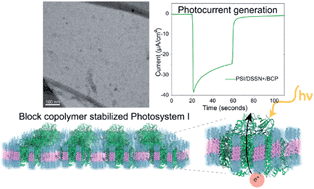Biomimetic wiring and stabilization of photosynthetic membrane proteins with block copolymer interfaces†
Abstract
Integrating photosynthetic membrane proteins with non-biological materials such as polymers and electrodes is attractive, as it could allow new ways of harvesting solar energy for direct electrical power, sensing, or chemical production. However, such integration is challenging, as these proteins have to be “wired” to electrodes and oriented to maximize light capture and electron transfer all while maintaining long-term activity. In this work we present a durable and unique solution to the challenges of stabilization and wiring of photosynthetic membrane proteins on electrodes. A block copolymer, poly(butadiene)12-poly(ethylene oxide)8 (PB12-PEO8), that mimics the bilayer assembly of lipids was used to stabilize photosystem I (PSI) in a near-native hydrophobic environment. At high protein concentrations, large, highly packed planar membranes (∼4 nm thick) were formed, which allowed high surface loading of protein at the electrode interface. To “wire” these membranes with metal electrodes, a conductive block copolymer bilayer based on the same PB12-PEO8 but with intercalated conjugated oligoelectrolytes (COEs) was used. This photo-active conductive layer was used to conduct electrons while maintaining a stabilizing cell membrane-like hydrated environment at the protein–metal interface. Photocurrents approaching 35.0 ± 3.5 μA cm−2 were generated upon illumination of these assembled devices with photosynthetically active radiation (PAR), among the highest reported so far for such systems on a per protein basis. This is the first application of membrane proteins completely stabilized in and on a block copolymer support for an energy-relevant electrochemical device and may represent the highest photocurrent generation per protein.


 Please wait while we load your content...
Please wait while we load your content...